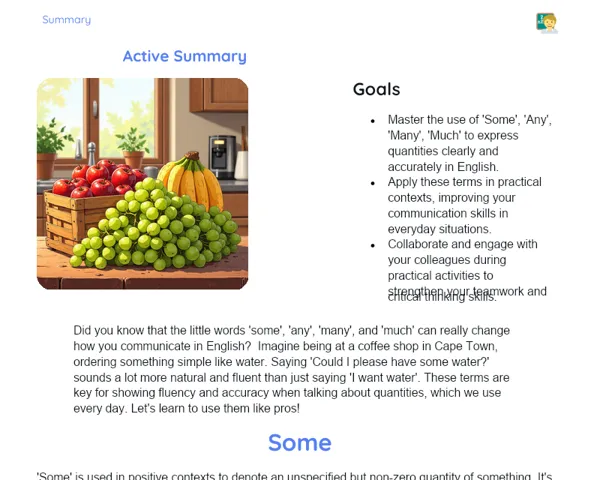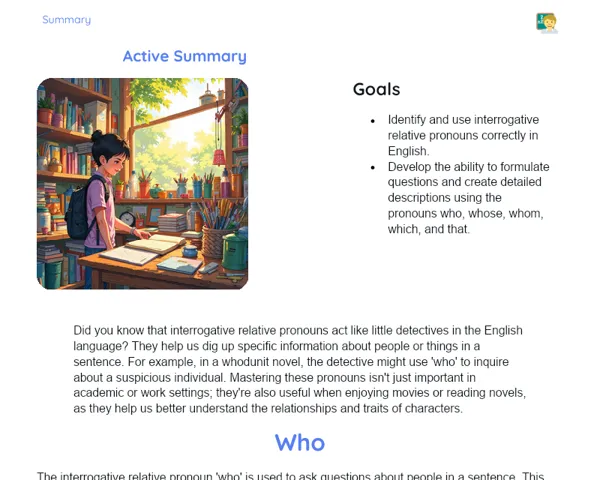Summary Tradisional | Some, Any, Many, Much
Contextualization
In English, mastering the use of 'some', 'any', 'many', and 'much' is vital for clear communication, particularly in terms of expressing quantities. These terms often come into play in various everyday situations, such as when shopping, seeking information, or making polite offers. Thus, having a solid grasp of when and how to use these words is an essential skill for any English learner.
The word 'some' commonly appears in positive sentences and is often seen in offers or polite requests, as in 'Would you like some coffee?'. Conversely, 'any' is mostly used in questions and negative statements, like 'Do you have any questions?' or 'I don't have any money'. In comparison, 'many' is employed for countable nouns, while 'much' pertains to uncountable nouns, as illustrated in 'How many apples do you have?' and 'How much water do you drink?'.
To Remember!
Some
'Some' is predominantly used in positive sentences and in scenarios where a person makes a polite offer or request. For instance, when saying 'I have some friends', we affirm our friendship without indicating an exact number. This is because 'some' expresses an indefinite but positive quantity. Additionally, 'some' is often found in questions that anticipate a positive response, such as 'Would you like some coffee?'.
Another common usage of 'some' is in offering or requesting something politely and informally. This is typical in social settings where being courteous and friendly is a priority. Examples include 'Could I have some water, please?' or 'Can you lend me some money?'.
It's worth noting that while 'some' is generally used in positive constructions, it may also appear in questions when a positive answer is anticipated, or when making an offer, as in 'Would you like some help?'. Understanding the context and intent behind the phrase is key to using 'some' appropriately.
-
'Some' is used in affirmative sentences to indicate an indefinite but positive quantity.
-
'Some' is common in offers or polite requests.
-
'Some' may appear in questions when an affirmative response is expected or when making an offer.
Any
'Any' is generally used in questions and negative sentences. In inquiries, 'any' helps ask about the existence of something, such as in 'Do you have any siblings?'. Here, 'any' signifies that we are curious about the existence of siblings without stating a number. Meanwhile, in negative sentences, 'any' indicates the lack of something, as in 'I don't have any money'; here, 'any' amplifies the absence of money.
Another usage of 'any' is in conditional contexts or scenarios that involve a choice. For example, 'You can take any book you like' suggests total freedom of choice, without limiting the selection.
It's important to note that 'any' is versatile and suitable for various contexts to express absence, possibility, or generalization. Using it correctly largely depends on whether the sentence is affirmative, negative, or interrogative, as well as the context it is in.
-
'Any' is used in questions to inquire about the existence of something.
-
'Any' is used in negative sentences to deny the existence of something.
-
'Any' can be employed in conditional sentences and contexts that involve choice or possibility.
Many
'Many' pertains to countable nouns and can be used in questions, affirmatives, and negatives. In questions, 'many' asks about the quantity of countable items, as in 'How many apples do you have?'. Here, 'many' seeks specific numbers. In negative statements, 'many' points to the lack of a large number of countable things, such as 'I don't have many books'.
Although more common in questions and negatives, 'many' can also be found in positive sentences to reflect a considerable quantity. For example, 'I have many friends' shows that the person has a substantial number of friends. This is less frequent but grammatically correct and can appear in more formal contexts.
Remember that 'many' strictly applies to countable nouns, which are items that can be enumerated. Understanding this distinction is essential for the correct application of 'many' in varying linguistic contexts.
-
'Many' is used with countable nouns in questions, negatives, and affirmative sentences.
-
'Many' inquires about the specific quantity of countable items.
-
'Many' is less common in affirmatives but can nonetheless indicate a large number of countable items.
Much
'Much' relates to uncountable nouns and is appropriate in questions, negatives, and affirmatives. In inquiries, 'much' helps ask about quantities that can't be individually counted, as in 'How much water do you drink?'. Here, 'much' seeks to determine the volume of water consumed. In negative contexts, 'much' indicates the lack of a significant amount of an uncountable term, as in 'I don't have much time'.
Though 'much' appears more frequently in questions and negatives, it can also occur in positive phrases, particularly in formal speech. For instance, 'There is much to be done' suggests that a lot of work is necessary. This usage is more uncommon in everyday conversation but essential for comprehending formal texts and discussions.
Importantly, 'much' is exclusively used with uncountable nouns, such as liquids, abstract concepts, and other indivisible entities. Acknowledging this distinction is fundamental for the proper use of 'much' across various contexts.
-
'Much' is used with uncountable nouns in questions, negative sentences, and affirmative sentences.
-
'Much' asks about the quantity of something that cannot be counted individually.
-
'Much' may also appear in positive statements, especially in formal scenarios.
Key Terms
-
Some: Affirmative sentences and polite offers/requests.
-
Any: Questions and negative statements.
-
Many: Countable nouns in all types of sentences.
-
Much: Uncountable nouns in all types of sentences.
Important Conclusions
In this lesson, we've delved into the use of 'some', 'any', 'many', and 'much' within English, focusing on expressing quantities. We established that 'some' is typically used in affirmative sentences and in polite settings to offer or request something, while 'any' primarily features in questions and negative situations. Furthermore, we noted that 'many' is limited to countable nouns and 'much' applies to uncountable nouns, each having particular roles in questions, negatives, and affirmatives.
A solid understanding of these terms is crucial for effective communication in English, enabling precise and appropriate expression of quantities across diverse contexts. Knowing when and how to implement 'some', 'any', 'many', and 'much' helps in sidestepping misunderstandings and enhances both fluency and accuracy in conversation and writing. These terms frequently surface in day-to-day interactions, including shopping, seeking information, or making offers, reinforcing the practical relevance of mastering them.
We encourage everyone to continue their exploration of these concepts, engaging with further examples and exercises. Cementing this knowledge is vital for language skill development and for more effective and confident communication in English. Seize opportunities to use these concepts in real-life situations and observe how employing these words correctly can elevate your daily exchanges.
Study Tips
-
Practice filling in exercises using 'some', 'any', 'many', and 'much' to reinforce understanding of these terms.
-
Read through English materials like articles, shorts stories, or dialogues, identifying instances of 'some', 'any', 'many', and 'much'. Pay attention to the contexts in which each word appears.
-
Craft your own sentences and questions using 'some', 'any', 'many', and 'much'. Practice with peers or in front of a mirror to build fluency and confidence in their usage.


